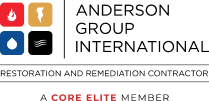FAQs
A Member of CORE Elite, AGI is the premier choice for property insurance, mitigation, repair, and remediation solutions.
Frequently Asked Questions
We offer comprehensive restoration and remediation services, including fire damage restoration, smoke damage cleanup, wind damage repair, environmental cleanup, and mold remediation. Our certified technicians are available 24/7 for emergency services.
Yes, our technicians are certified through IICRC and trained in the latest techniques for fire damage restoration, smoke damage cleanup, wind damage repair, and mold remediation.
Yes, we offer 24/7 emergency services for fire damage restoration, smoke damage cleanup, wind damage repair, environmental cleanup, and mold remediation.
Fire & Smoke Damage
Our team conducts a thorough damage assessment, including extensive and detailed photos, removes debris, cleans and deodorizes affected areas, and restores or replaces damage to the structure and belongings as part of our fire damage restoration and smoke damage cleanup services.
The duration of fire damage restoration depends on the extent of the damage and the size of the structure. We provide a detailed fire damage repair estimate after a comprehensive assessment.
Wind Damage
We assess the structural damage, secure the property to prevent further issues, and perform necessary repairs or replacement to restore your property to its pre-damage condition.
Environmental & Mold Damage
Our mold remediation process starts with a thorough mold inspection by a third-party expert to identify sources. Then we proceed with safe mold removal, containment of affected areas, and repairs to prevent future mold growth. We follow strict safety protocols throughout the process.
Yes, we adhere to strict safety protocols and use specialized equipment to ensure safe mold remediation and environmental cleanup, protecting both our clients and technicians.
Additional Services
Yes, we use specialized cleaning techniques to restore personal items affected by fire, smoke, wind, or mold damage whenever possible. We also utilize a team of experts wo specialize in cleaning and restoring electronics, artwork, and antique textiles.
Mitigation
Mitigation refers to the steps taken to minimize the damage caused by a disaster, such as a flood or fire. It is important because it helps to prevent further damage, reduces recovery costs, and ensures a quicker return to normalcy.
Mitigation should begin as soon as possible, ideally within the first 24-48 hours. Prompt action helps to prevent secondary damage, such as mold growth or structural degradation.
The mitigation process typically involves assessing the damage, removing any standing water, removing bulk contaminants, drying out affected areas, cleaning and disinfecting, and repairing or replacing damaged building materials.
Water Extraction
Water extraction is the process of removing standing water from a property following a flood, leak, or other water intrusion event. It is needed to prevent further damage, reduce the risk of mold growth, and begin the drying process.
The duration of the water extraction process depends on the extent of the water damage and the size of the affected area. It can take anywhere from a few hours to a couple of days.
Yes, timely and thorough water extraction can prevent mold growth by removing excess moisture, which is a key factor for mold development.
Dry Out
The dry out process occurs after the water extraction phase and involves removing moisture from affected building materials to prevent further damage and mold growth. It is necessary to restore the property to a safe and habitable condition.
Equipment used during the dry out process includes desiccant and refrigerant dehumidifiers, air movers, HEPA filtered air scrubbers and moisture meters to ensure thorough and efficient drying to reach an equilibrium moisture content of structures.
Professionals use moisture meters and thermal imaging cameras to detect any remaining moisture. A property is considered completely dry when moisture levels are back to an equilibrium moisture content.
Contents Cleaning & Storage
The contents cleaning process involves photographing and inventorying and cleaning and restoring personal belongings that have been affected by a disaster. This can include washing, drying, disinfecting, and deodorizing items.
Belongings are stored in a secure facility to prevent further damage while they are being cleaned and restored. Contents are stored in furniture vaults to ensure customer items are not co-mingled.
HVAC Duct & Unit Cleaning
Cleaning HVAC ducts and units is important to improve indoor air quality, increase the efficiency of your HVAC system, and reduce the risk of mold and allergens circulating in your home.
It is recommended to clean HVAC ducts and units every 3-5 years, or more frequently if there are specific concerns such as mold growth, allergies, recent renovations, or staining at registers.
Signs that your HVAC system needs cleaning include visible dust and debris in the ducts, unusual odors, decreased airflow, and an increase in allergy symptoms.
Hypersensitive (High Sensitive) Mold Remediation
Hypersensitive mold remediation is a specialized and detailed process designed for individuals who are highly sensitive to mold. It involves extra precautions to ensure that mold spores are eliminated and that the environment is safe for those with severe mold allergies or compromised immune systems.
Hypersensitive mold remediation involves more stringent containment measures, thorough cleaning with HEPA filtration, and sometimes the use of specialized cleaning agents to ensure a somewhat mold-free environment.
Precautions include the use of full containment barriers, negative air pressure, HEPA air scrubbers, and detailed cleaning protocols to remove mold spores and prevent cross-contamination to occupied areas.
Equipment Rental
We offer a wide range of equipment for rental, including dehumidifiers (commercial, industrial, residential), air movers, HEPA air scrubbers, moisture meters, water extraction units, and generators.
Our team can assess your project and recommend the appropriate equipment based on the extent of the damage and the specific needs of your property.
Rental terms and conditions vary, but typically include a rental period, daily, weekly or monthly rates, and requirements for equipment care. Please contact us for detailed terms specific to your needs.
